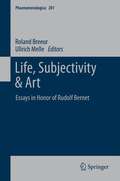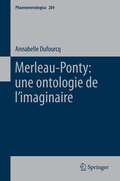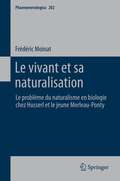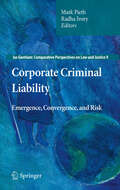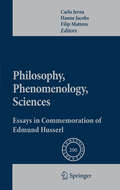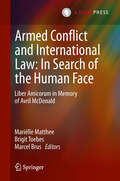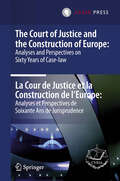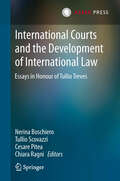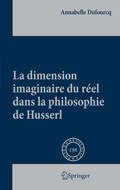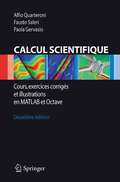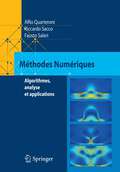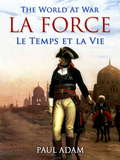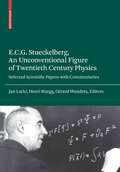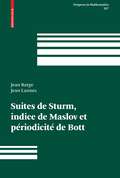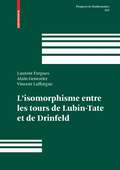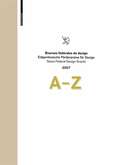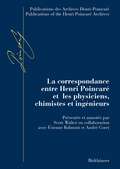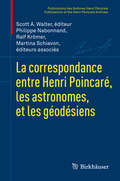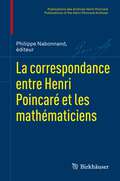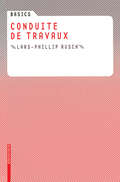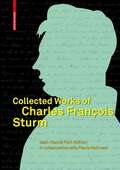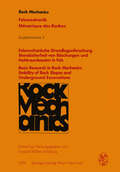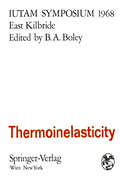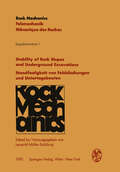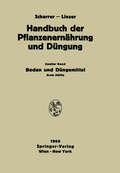- Table View
- List View
Life, Subjectivity & Art: Essays in Honor of Rudolf Bernet (Phaenomenologica #201)
by Roland Breeur Ullrich MelleThis book contains essays written by eminent phenomenologists & scholars closely related to R. Bernet, a person and a philosopher (colleagues, friends and collaborators, former students). The intellectual and worldwide authority of R. Bernet's work is well represented by the list of contributors, as well as by the content of their chapters. In a sense, this volume is a good indication of the importance of Bernet's own books, articles and classes. The editors have chosen to concentrate the contributions on what could be estimated to be one of the three major themes of his philosophical itinerary: life, seen from a phenomenological point of view, its relation to subjectivity, experiences and consciousness, and both seen as the ground for an original reflection on art (paintings).
Merleau-Ponty: une ontologie de l’imaginaire (Phaenomenologica #204)
by Annabelle DufourcqCette étude a pour objet la conception merleau-pontyenne de l’imaginaire et la manière dont elle conduit à repenser radicalement le réel dans sa totalité et, finalement, à imposer une ontologie dont l’imaginaire est le principe même, « l’institution de l’Etre ».
Le vivant et sa naturalisation: Le problème du naturalisme en biologie chez Husserl et le jeune Merleau-Ponty (Phaenomenologica #202)
by Frédéric MoinatCe volume propose une étude articulée de Husserl et de Merleau-Ponty qui prend comme perspective la dimension épistémologique de leur philosophie relativement à la biologie. Chacun à sa manière, ils se sont penchés sur le statut ambigu de la biologie et sur l’épineuse question du naturalisme, à savoir : dans quelle mesure les êtres vivants peuvent-ils être appréhendés comme des ensembles de processus physiques et chimiques ? La confrontation de leurs deux contributions à la question offre un éclairage qui a conservé toute sa pertinence, alors que le développement de la biologie moléculaire et des neurosciences contemporaines a amené un retour du paradigme naturaliste en biologie. L’étude débouche sur une mise en perspective avec la théorie biologique de l’autopoïèse élaborée par F. Varela et H. Maturana. L’enjeu final est de proposer une théorie de la biologie qui respecte son irréductibilité tout en tenant compte du rôle de plus en plus important que les approches physico-chimiques jouent dans notre compréhension des êtres vivants.
Corporate Criminal Liability: Emergence, Convergence, and Risk (Ius Gentium: Comparative Perspectives on Law and Justice #9)
by Mark Pieth and Radha IvoryWith industrialization and globalization, corporations acquired the capacity to influence social life for good or for ill. Yet, corporations are not traditional objects of criminal law. Justified by notions of personal moral guilt, criminal norms have been judged inapplicable to fictional persons, who ‘think’ and ‘act’ through human beings. The expansion of new corporate criminal liability (CCL) laws since the mid-1990s challenges this assumption. Our volume surveys current practice on CCL in 15 civil and common law jurisdictions, exploring the legal conditions for liability, the principles and options for sanctioning, and the procedures for investigating, charging and trying corporate offenders. It considers whether municipal CCL laws are converging around the notion of ‘corporate culture’, and, in any case, the implications of CCL for those charged with keeping corporations, and other legal entities, out of trouble.
Philosophy, Phenomenology, Sciences: Essays in Commemoration of Edmund Husserl (Phaenomenologica #200)
by Carlo Ierna Hanne Jacobs Filip MattensThe present volume contains many of the papers presented at a four-day conference held by the Husserl-Archives in Leuven in April 2009 to c- memorate the one hundred and ?ftieth anniversary of Edmund Husserl’s birth. The conference was organized to facilitate the critical evaluation of Husserl’s philosophical project from various perspectives and in light of the current philosophical and scienti?c climate. Still today, the characteristic tension between Husserl’s concrete and detailed descriptions of consciousness, on the one hand, and his radical philosophical claim to ultimate truth and certainty in thinking, feeling, and acting, on the other, calls for a sustained re?ection on the relation between a Husserlian phenomenological philosophy and philosophy in general. What can phenomenological re?ection contribute to the ongoing discussion of certain perennial philosophical questions and which phi- sophical problems are raised by a phenomenological philosophy itself? In addition to addressing the question of the relation between p- nomenology and philosophy in general, phenomenology today cannot avoid addressing the nature of its relation to the methods and results of the natural and human sciences. In fact, for Husserl, phenomenology is not just one among many philosophical methods and entirely unrelated to the sciences. Rather, according to Husserl, phenomenology should be a “?rst philosophy” and should aim to become the standard for all true science.
Armed Conflict and International Law: Liber Amicorum in Memory of Avril McDonald
by Mariëlle Matthee, Brigit Toebes and Marcel BrusThis book is written in memory of Avril McDonald, who passed away in April 2010. Avril was an inspired and passionate scholar in the fields of international humanitarian law, international criminal law, human rights law and law in the field of arms control and disarmament. What in particular made Avril’s work special, was her strong commitment with the human aspects throughout. Fourteen scholars and practitioners have contributed to this liber amicorum, which has led to a rich variety of topics within the disciplines of Avril’s expertise. They all have in common that they deal with the human perspectives of the discipline of law at hand. They concentrate on the impact of the developments in international law on humans, whether they are civilians, victims of war or soldiers. This human perspective of law makes this book an appropriate tribute to Avril McDonald and at the same time a unique and valuable contribution to international legal research in the present society. A society that becomes more and more characterized by detailed legal systems, defined by institutions that may frequently lack sufficient contact with the people concerned.
The Court of Justice and the Construction of Europe: Analyses and Perspectives on Sixty Years of Case-law -La Cour de Justice et la Construction de l'Europe: Analyses et Perspectives de Soixante Ans de Jurisprudence
by A. Rosas E. Levits Y. BotThis book is a contributed volume published by the Court of Justice of the European Union on the occasion of its 60th anniversary. It provides an insight to the 60 years of case-law of the Court of Justice and its role in the progress of European Integration. The book includes contributions from eminent jurists from almost all the EU Member States. All the main areas of European Union are covered in a systematic way. The contributions are regrouped in four chapters dedicated respectively to the role of the Court of Justice and the Judicial Architecture of the European Union, the Constitutional Order of the European Union, the Area of EU Citizens and the European Union in the World. The topics covered remain of interest for several years to come. This unique book, a "must-have" reference work for Judges and Courts of all EU Members States and candidate countries, and academics and legal professionals who are active in the field of EU law, is also valuable for Law Libraries and Law Schools in Europe, the United States of America, Latin America, Asia and Africa and law students who focus their research and studies in EU law.
International Courts and the Development of International Law: Essays in Honour of Tullio Treves
by Nerina Boschiero, Tullio Scovazzi, Cesare Pitea and Chiara RagniThis book contains a collection of essays by leading experts linked to the outstanding characteristics of the scholar in honour of whom it is published, Tullio Treves, who combines his academic background with his practical experiences of a negotiator of international treaties and a judge of an international tribunal. It covers international public and private law related to international courts and the development of international law.Under Article 38 of its Statute, the International Court of Justice can apply judicial decisions only as a “subsidiary means for the determination of rules of law”. However, there are many reasons to believe that international courts and tribunals do play quite an important role in the progressive development of international law. There are a number of decisions which are inevitably recalled as the first step, or a decisive step, in the process of the formation of a new rule of customary international law. In these cases, can the judge be considered as a subsidiary of others? Are these cases compatible with the common belief that a judge cannot create law? Is this a peculiarity of international law, which is characterized by the existence of several courts but the lack of a legislator? Do decisions by different courts lead to the consequence of a fragmented international law? This volume provides the reader with an elaboration of various questions linked to the legislative role of courts.In their choices of subjects, some contributors have taken into account the general aspects of the development of international rules through court decisions or specific sectors of international law, such as human rights, international crimes, international economic law, environmental law and the law of the sea. Others have chosen the subject of the rules on jurisdiction and procedure of international courts. The question of the courts’ role in the development of areas of law different from public international law, namely private international law and European Union law, has also been considered.The information and views contained in this book will be of great value to academics, students, judges, practitioners and all others interested in the public and private international law aspects of the link between international courts and the development of international law.
La dimension imaginaire du réel dans la philosophie de Husserl (Phaenomenologica #198)
by Annabelle DufourcqCette étude propose une analyse précise de la conception husserlienne des images et de l’imagination. Il s’agit d’en recenser les principaux traits et de fixer les définitions des notions clés. L’enjeu de ce travail dépasse largement la seule question de la nature de l’imagination : la manière dont Husserl repense l’imaginaire implique un bouleversement profond de notre conception du réel même. Ce dernier se révèle être beaucoup moins implacable, plus spirituel et flottant qu’on ne le croit communément. On peut montrer corrélativement que cette conception originale de l’imaginaire apporte un éclairage nouveau sur la réflexion de Husserl concernant la crise.
Calcul Scientifique: Cours, exercices corrigés et illustrations en Matlab et Octave
by Alfio Quarteroni Fausto Saleri Paola GervasioCe livre constitue une introduction au Calcul Scientifique. Son objectif est de présenter des méthodes numériques permettant de résoudre avec un ordinateur certains problèmes mathématiques qui ne peuvent être traités simplement avec un papier et un crayon. Les questions classiques du Calcul Scientifique sont abordées: la recherche des zéros ou le calcul d'intégrales de fonctions continues, la résolution de systèmes linéaires, l'approximation de fonctions par des polynômes, la résolution approchée d'équations différentielles. La présentation de ces méthodes est rendue vivante par le recours systématique aux environnements de programmation Matlab et Octave dont les principales commandes sont introduites progressivement. Tous les algorithmes sont présentés sous la forme de programmes. Ceci permet de vérifier très rapidement leurs propriétés théoriques, en particulier la stabilité, la précision et la complexité. La résolution de divers problèmes, souvent motivés par des applications concrètes, fait l'objet de nombreux exemples et exercices. À la fin de chaque chapitre, une section présente des aspects plus avancés et fournit des indications bibliographiques qui permettront au lecteur d'appronfondir les connaissances acquises. Le dernier chapitre est consacré à la correction des exercices proposés tout au long du livre
Méthodes Numériques: Algorithmes, analyse et applications
by Alfio Quarteroni Riccardo Sacco Fausto SaleriCe livre a pour but de présenter les fondements théoriques et méthodologiques de l'analyse numérique. Une attention toute particulière est portée sur les concepts de stabilité, précision et complexité des algorithmes. Les méthodes modernes relatives aux thèmes suivants sont presentées et analysées en détail : résolution des systèmes lineaires et non linéaires, approximation polynomiale, optimisation, intégration numérique, polynômes orthogonaux, transformations rapides, équations différentielles ordinaires. Les techniques presentées sont illustrées par de nombreux tableaux et figures. Beaucoup d'exemples et de contre-exemples sont proposés pour permettre au lecteur de développer son sens critique. Une caractéristique principale du livre réside dans l'abondance des programmes MATLAB qui accompagnent toutes les méthodes numériques présentées et qui les illustrent par des applications concrètes. Le lecteur détient ainsi tous les outils pour acquérir de solides connaissances théoriques et les appliquer directement sur ordinateur. Cet ouvrage s'adresse aux étudiants du second cycle des universités, aux élèves des écoles d'ingénieurs et, plus généralement, à toutes les personnes qui pratiquent le calcul scientifique.
La Force / Le Temps et la Vie (The World At War)
by Paul AdamPaul Auguste Marie Adam1, né le 6 décembre 1862 à Paris où il est mort le 2 janvier 1920, est un écrivain français et critique d'art. Partisan du général Boulanger, il milite dans les mouvements nationalistes et traditionalistes et, pendant la Première Guerre mondiale, il se rend auprès des troupes pour soutenir leur moral et fonde la Ligue intellectuelle de fraternité latine. Parallèlement, il publie de très nombreux ouvrages : essais, romans, nouvelles, récits de voyage, parmi lesquels on peut citer les romans de son cycle napoléonien : La Force (1899), L'Enfant d'Austerlitz (1901), Au soleil de juillet (1903), ainsi que La Ruse (1903) et Stéphanie (1913). (Excerpt from Wikipedia)
E.C.G. Stueckelberg, An Unconventional Figure of Twentieth Century Physics: Selected Scientific Papers with Commentaries
by Jan Lacki Henri Ruegg Gérard WandersBorn in 1905, Ernst C. G. Stueckelberg was professor of theoretical physics at the Universities of Geneva and Lausanne in the years 1930-1970. He was one of the most eminent Swiss physicists of the 20th century. His breakthroughs, from his causal S-matrix to the renormalization group, have influenced the development of contemporary theoretical physics. The book presents a selection of his most important scientific papers. They are preceded with a series of introductory essays, contributed by scientists and historians, specialists of Stueckelberg’s achievements and time. These essays deal with the scientific context and the issues of the various topics that Stueckelberg tackled in his scientific career and serve as an enlightening complement to the reprinted papers. The volume also contains Stueckelberg’s concise biography and an exhaustive list of his publications. It ambitions to provide an authoritative source gathering in a single place all the material needed to assess the scientific achievements of one of the most important, albeit somehow overlooked, scientists of 20th century.
Suites de Sturm, indice de Maslov et périodicité de Bott (Progress in Mathematics #267)
by Jean Barge Jean LannesLa théorie classique des suites de Sturm fournit un algorithme pour déterminer le nombre de racines d’un polynôme à coefficients réels contenues dans un intervalle donné. L’objet principal de ce mémoire est de montrer qu’une généralisation adéquate de la théorie des suites de Sturm fournit entre autres choses: une notion d’indice de Maslov pour un lacet algébrique de lagrangiens défini sur un anneau commutatif; une démonstration du théorème fondamental de la K-théorie (algébrique) hermitienne, théorème dû à M. Karoubi; une démonstration des théorèmes de périodicité de Bott (topologique), dans l’esprit des travaux de F. Latour; un calcul du groupe K2 relatif, symplectique-linéaire, pour tous les anneaux commutatifs, dans l’esprit des travaux de R. Sharpe. Le livre est dans la mesure du possible « self-contained » et élémentaire: il met essentiellement en oeuvre des arguments d’algèbre linéaire ou bilinéaire. Il présente une approche unifiée de l’indice de Maslov en termes de suites de Sturm et de formes quadratiques.
L'isomorphisme entre les tours de Lubin-Tate et de Drinfeld (Progress in Mathematics #262)
by Laurent Fargues Alain Genestier Vincent LafforgueCe livre contient une démonstration détaillée et complète de l'existence d'un isomorphisme équivariant entre les tours p-adiques de Lubin-Tate et de Drinfeld. Le résultat est établi en égales et inégales caractéristiques. Il y est également donné comme application une démonstration du fait que les cohomologies équivariantes de ces deux tours sont isomorphes, un résultat qui a des applications à l'étude de la correspondance de Langlands locale. Au cours de la preuve des rappels et des compléments sont donnés sur la structure des deux espaces de modules précédents, les groupes formels p-divisibles et la géométrie analytique rigide p-adique. This book gives a complete and thorough proof of the existence of an equivariant isomorphism between Lubin-Tate and Drinfeld towers in infinite level. The result is established in equal and inequal characteristics. Moreover, the book contains as an application the proof of the equality between the equivariant cohomology of both towers, a result that has applications to the local Langlands correspondence. Along the proof background and complements are given on the structure of both moduli spaces, p-divisible formal groups and p-adic rigid analytic geometry.
Bourses fédérales de design / Eidgenössische Förderpreise für Design / Swiss Federal Design Grants 2007: A–Z (Eidgenössische Förderpreise für Design Bourses fédérales de design Swiss Federal Design Grants #2007)
by Lorette Coen Patrizia Crivelli Susanne Hilpert Stuber Aurelia Müller Chantal Prod'HomAnlässlich des jährlich stattfindenden Eidgenössischen Wettbewerbs für Design realisiert das Bundesamt für Kultur eine Publikation und eine Ausstellung – in diesem Jahr in Zusammenarbeit mit dem Musée de design et d'arts appliqués contemporains in Lausanne. Sie dienen als Plattformen, um alle Preisträgerinnen und Preisträger sowie ihre ausgezeichneten Werke vorzustellen und zu dokumentieren. Zu sehen sind Werke aus den Bereichen Mode, Textil, Grafik, Illustration, Fotografie, Produktdesign und Schmuck. Die grafische Gestaltung dieser Publikation wurde an BONBON, Diego Bontognali, Valeria Bonin mit Esther Rieser vergeben.
La correspondance entre Henri Poincaré et les physiciens, chimistes et ingénieurs (Publications des Archives Henri Poincaré Publications of the Henri Poincaré Archives)
by Scott Walter Etienne Bolmont André CoretL'intérêt que portait Henri Poincaré (1854-1912) à des questions d'ordre physique a été durable et profond; elle couvre presque toute sa carrière, et marque l'histoire de la physique tout au long du 20ème siècle. Sa correspondance avec cinquante-et-un physiciens, quatre chimistes, et cinq ingénieurs commence dès 1879, lorsqu'il s'engage activement dans la recherche scientifique. Elle est rythmée par des grandes découvertes d'ordre expérimental, instrumental, et théorique. Henri Poincaré, while well-known as the most brilliant mathematician at the close of the 19th century, is also a founder of 20th-century physics, in virtue of his fundamental contributions to Maxwell's theory, systems dynamics, electron theory, relativity and quantum theory. These subjects and others are discussed in this critical edition of his correspondence with sixty physicists, chemists, and engineers.
La correspondance entre Henri Poincaré, les astronomes, et les géodésiens (Publications des Archives Henri Poincaré Publications of the Henri Poincaré Archives)
by Scott Walter Ralf Krömer Philippe Nabonnand Martina SchiavonThe letters in this volume cover Poincaré's multifaceted career in astronomy in its entirety, extending from the time of his first publications in 1880 to the end of his life in 1912. At a tender age, Poincaré established his authority in questions of celestial mechanics, and his views were soon sought after on a vast array of questions by the leading astronomers and geodesists of his time, including C.V.L. Charlier, G.H. Darwin, H. Faye, F.R. Helmert, G. W. Hill, A. Lindstedt, A.M. Liapunov, N. Lockyer, S. Newcomb, K. Schwarzschild, and F. Tisserand. Poincaré and his correspondents take up topics ranging from the three-body problem and perturbation theory to the determination of the geoide and the equilibrium figures of rotating fluid masses. The volume also sheds light on Poincaré's three terms as president of the Bureau of Longitudes, where he guided French astronomy and geodesy through ambitious projects, such as the measurement of an arc of meridian near Quito.------Les lettres du troisième volume de la Correspondance de Poincaré scandent toute son œuvre astronomique, allant de ses premiers mémoires sur les courbes définies par une équation différentielle (1881), jusqu'aux analyses des hypothèses cosmogoniques (1911). Encore très jeune, Poincaré s'est fait remarquer pour sa maîtrise des questions de la mécanique céleste, de tel sorte que les astronomes et les géodésiens l'ont souvent interpellé, y compris O. Callandreau, C.V.L. Charlier, G.H. Darwin, F.R. Helmert, A. Lindstedt, A.M. Lyapunov, Simon Newcomb, Karl Schwarzschild et F. Tisserand.Avec ses correspondants, Poincaré abordaient les questions principales de l'astronomie mathématique, du célèbre problème des trois corps à la théorie des perturbations et aux figures d'équilibre des masses fluides en rotation. La correspondance de Poincaré éditée et annotée dans ce volume concerne, au-delà des mémoires mathématiques, l'activité de Poincaré en tant que Professeur d'astronomie mathématique et de mécanique céleste à la Sorbonne, rédacteur en chef duBulletin astronomique, et membre du Bureau des longitudes, que Poincaré a présidé à trois reprises. Sa correspondance illumine, dans ce dernier cadre, la réalisation de la mesure d'un arc de méridien à Quito, et le règlement d'un différend franco-brittanique à propos de la différence de longitude entre Greenwich et Paris.
La correspondance entre Henri Poincaré et les mathématiciens (Publications des Archives Henri Poincaré Publications of the Henri Poincaré Archives)
by Jean Mawhin David Rowe Klaus Volkert Scott A. Walter Philippe Nabonnand Olivier Bruneau Jeremy J. Gray Gerhard Heinzmann Philippe HenryIndispensable for understanding Henri Poincaré's vast activity in the mathematical sciences. Provides new sources revealing Poincaré's involvement as president of the "Commission permanente du Répertoire bibliographique des sciences mathématiques" as an actor in the "Dreyfus Affair," and on his links with the editors of the major mathematical journals.The letters, many of which are unpublished, are fully annotated with an emphasis on the academic, cultural and technical contexts. An introduction underlines the lessons that can be drawn from the reading of these correspondences on Poincaré's position in the mathematical and academic communities. Three indexes facilitate the reading.Le volume de la correspondance de Poincaré consacré à ses échanges avec les mathématiciens permet de suivre son investissement dans le champ des sciences mathématiques de ses débuts comme étudiant brillant et prometteur préparant une thèse jusqu’à ses derniers jours, où devenu une icone pour la communauté mathématique depuis de longues années, sa correspondance traduit autant son activité dans la recherche que son implication dans les questions académiques, institutionnelles et organisationnelles. Les questions liées à la théorie des équations différentielles et l’entreprise du Répertoire bibliographique des sciences mathématiques ont suscité une activité épistolaire particulièrement sensible par le nombre de lettres qui y font allusion et par la diversité des correspondants qui abordent les questions de bibliographie mathématique. Les correspondances sont aussi l’occasion de multiples partages d’informations mathématiques, académiques et éditoriales.
Basics Conduite de travaux (Basics)
by Lars-Philip RuschLa conduite des travaux constitue un champ d’action important et intéressant pour les architectes. Cet ouvrage décrit de façon pratique et claire les différentes tâches de l’architecte dans le contrôle des travaux. Outre la surveillance générale de la construction et le contrôle de la qualité d’exécution, il aborde également ce qui concerne les relevés, les feuilles d’attachement, la gestion des coûts et des prestations supplémentaires.
Collected Works of Charles François Sturm
by Flavia PadovaniThis volume is based on lectures presented at a colloquium held in Geneva in 2003 to honour the 200th anniversary of the birth of Charles François Sturm in Geneva on September 29, 1803. The focus is on C.F. Sturm's own work and this is the first monograph on his collected papers. These original papers are accompanied by contributions from internationally renowned experts thereby deepening topics like differential equations, optics and algebraic curves.
Felsmechanische Grundlagenforschung Standsicherheit von Böschungen und Hohlraumbauten in Fels / Basic Research in Rock Mechanics Stability of Rock Slopes and Underground Excavations: Vorträge des 21. Geomechanik-Kolloquiums der Österreichischen Gesellschaft für Geomechanik / Contributions to the 21st Geomechanical Colloquium of the Austrian Society for Geomechanics (Rock Mechanics Felsmechanik Mecanique des roches. Supplementa #3)
by L. Müller-SalzburgThermoinelasticity: Symposium East Kilbride, June 25–28, 1968 (IUTAM Symposia)
by Bruno A. BoleyThe proposal for a Symposium on high temperature effects in solids originated in 1964, at which time a pilot committee, headed by Professor F. K. G. ODQVIST, was formed. Upon the recommendation of this com mittee, a site for the Symposium and a Scientific Organizing Committee were chosen, and some guidelines delineating the field to be covered were established. The Symposium was held at the National Engineering Laboratory in East Kilbride (Glasgow), Scotland, from June 25 to 28, 1968. The Scientific Organizing Committee was composed of the following mem bers: Professor B. A. BOLEY, Chairman (U. S. A.) Professor F. BUCKENS (Belgium) Professor F. K. G. ODQVIST (Sweden) Professor W. OLSZAK (Poland) Professor H. PARKUS (Austria) Dr. D. G. SOPWITH (U. K.) The Local Organizing Committee was subsequently formed; it was direct ed by Dr. SOPWTTH with Mr. R. BRODIE as Secretary, and Mr. C. E. PHILLIPS and Dr. J. GLEN as additional members. It deserves ample praise for excellent arrangements and hospitality. In the discussions concerned with the goals of the Symposium, it was decided that its principal aim should be the presentation of a comprehen sive view of the behavior of solids and structures at high temperature under any type of inelastic regime. It soon became apparent that this was a very wide field, since it would embrace questions ranging from those of basic thermodynamic to those of engineering analysis and design.
